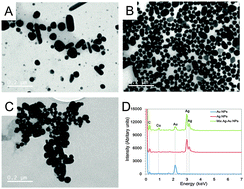White light-activated antimicrobial surfaces: effect of nanoparticles type on activity†
Abstract
Toluidine blue O (TBO) dye together with either silver (Ag) nanoparticles (NPs), gold (Au) NPs, or a mixture of Ag and Au NPs (Mix Ag–Au NPs) were incorporated into polyurethane to make antimicrobial surfaces using a swell-encapsulation-shrink process. Antimicrobial testing against Escherichia coli showed that inclusion of the NPs significantly enhanced the antimicrobial activities of the TBO polyurethane samples. In particular, samples containing Ag NPs exhibited potent antimicrobial activity under white light and surprisingly, also in the dark. The numbers of viable bacteria decreased below the detection limit on the TBO/Ag NPs incorporated samples within 3 h and 24 h under white light and dark conditions. A mechanistic study using furfuryl alcohol indicated that the enhanced photobactericidal activity was most likely due to a type I photochemical reaction. To the best of our knowledge, this is the first report of an antimicrobial surface comprised of a combination of Ag NPs and a light activated agent to provide a dual kill mechanism. These surfaces are promising candidates for use in healthcare environments to reduce the incidence of hospital-acquired infections.


 Please wait while we load your content...
Please wait while we load your content...